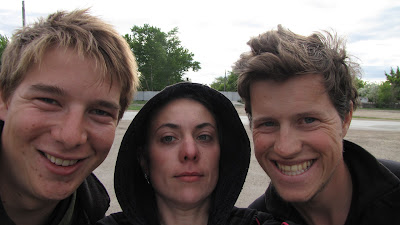Nest searching
(and finding) has started! This week we all arrived in the village of
Korgalzhyn, right in the middle of the Kazakh steppe and the Black Lark’s
breeding area. We directly started of finding nests, since the Black Lark
breeding season has already started. To the steppe!
The steppe
is often described as an endless sea of grass, which implies that it is very
monotone. Although endless, the steppe is far from monotone. Currently the wild
tulips are flowering and color the steppe with yellow, white and pink flowers.
Orange tulips are rare and finding one will bring happiness for the rest of
your life! We already found some orange ones, we hope this will give us luck in
finding nests.
Black Larks
are ground breeders and make deep cup-shaped nests (7 cm deep) in small scrapes
in the soil. These nests are often located next to tufts of grass. The female
scrapes out the nest, then adds small pieces of grass as lining. Often she adds
pieces of dung as a pavement. During this study we want to find out why the
birds do that.
Finding the
nests is a time consuming business. In an old Lada Niva, we drive across tracks
over the steppe. Black Larks often nest close to these tracks, and by driving
we hope to flush the females from their nests. When a female flies off, we
start looking for the nest on the spot she flew off. Sometimes we indeed
flushed her from the nest and the nest is quickly found, but often she was
either foraging or doing something else and finding the nest requires a bit more
luck. So far we have found 22 nests with eggs and 13 nests which were still in
the building phase. These latter nests might be used, but the birds might also
decide to build a new nest somewhere else.
Once we
find a nest we note down the location, the number of eggs, and data on the
surrounding vegetation. Also we count the number of dung pellets and the
direction in which the dung pavement is build. Dung might help to protect the
nest against cold wind. If dung buffers the nest against the cold, this might
have effect on the time a female can be off the eggs to feed. For this reason
we want to keep track for how long the female leaves the nest in between
incubation. We measure this using temperature loggers placed in the nest. We
modified Ibuttons (as you can read in our last blog post) to fit on nails. We
push a nail trough the nest into the soil and put the Ibutton on the nail with
Velcro. In this way the Ibuttons fit snuggly on the bottom of the nest and the
bird is unable to remove them.
Next to
black Larks we keep our eyes open for other birds. Bird migration is still in
full swing, with hundreds of Yellow Wagtails (subsp. beema) and large numbers
of others birds, including one of the largest fall in recent years (according
to the local birders) of Lesser Whitethroats , Siberian Chiffchaffs, Common
Redstarts and Wrynecks.
 |
| Female Black Lark |
 |
| Demoiselle Crane |
 |
| Eurasian Wryneck |
 |
| How the buttons fit in the nest. We now fit the buttons under the lining |
 |
| Huge fields of wild Tulips |
 |
| Huge fields of wild Tulips |
 |
| Enjoying free time |



















